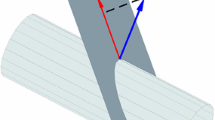Abstract
The aim of the paper was to investigate whether accurate, point-based registration of the intra-operative femur will be achieved within the context of minimally invasive surgery for total hip replacement. Computer tomography images, collected for pre-operative planning purposes, were used to simulate the intra-operative registration procedure using algorithms for various levels of measurement noise, different small areas of the femur available to the surgeon, and a limited number of collected data points (20–60). This helped with the choice of design variables to perform in vitro registration on a plastic bone model to validate the procedure, which included a multistart algorithm developed for intra-operative registration. The algorithm minimised the distance between the measured and image-derived surfaces and was able to cope with the presence of multiple local minima given sufficient computational effort, even with realistically large measurement noise. It was found that, if a small patch of the femur was used, accessible by a needle that could at times penetrate thin layers of soft tissue, errors in the order of 1.0 mm in translation and 0.5° in rotation were achievable.
Similar content being viewed by others
References
Audette, M., Ferrie, F., andPeters, T. (2000): ‘An algorithmic overview of surface registration techniques for medical imaging’,Med. Image Anal.,4, pp. 201–17
Bächler, R., Bunke, H., andNolte, L.-P. (2001): ‘Restricted surface matching—Numerical optimization and technical evaluation’,Comput. Aided Surg.,6, pp. 143–152
Bargar, W. L., Bauer, A., andBörner, M. (1998): ‘Primary and revision total hip replacement using the Robodoc® system’,Clin. Orthopaed. Rel. Res.,354, pp. 82–91
Besl, P., andMcKay, N. (1992): ‘A method for registration of 3-D shapes’,IEEE Trans. Pattern Anal. Mach. Intell.,14, pp. 239–256
Ellis, R. E., Fleet, D. J., Bryant, J. T., Rudan, J., andFenton, P. (1997): ‘A method for evaluating CT-based registration’,Springer Lecture Notes Comput. Sci.,1205, pp. 141–150
Gehrke, T., Wiese, K., Hahne, H., andHassenpflug, J. (1999): ‘Accuracy of spatial positioning of robot assisted hip prosthesis’,Comput. Aided Surg.,4, pp. 160
Grimson, W. E. L., Ettinger, G. J., White, S. J., Lozano-Pérez, T., W. M. Wells, I., andKikinis, R. (1996): ‘An automatic registration method for frameless stereotaxy, image guided surgery, and enhanced reality visualization’,IEEE Trans. Med. Imag.,15, pp. 129–140
Gueziec, A., Kazanzides, P., Williamson, B., andTaylor, R. H. (1998): ‘Anatomy-based registration of CT-scan and intraoperative X-ray images for guiding a surgical robot’,IEEE Trans. Med. Imag.,17, pp. 715–728
Herring, J. L. D., Maurer, C. R. Jr., Muratore, D. M.; Galloway, R. L., andFitzpatrick, J. M. (1998): ‘Surface-based registration of CT images to physical space for image-guided surgery of the spine: a sensitivity study’,IEEE Trans. Med. Imag.,17, pp. 743–752
Johnson, N. L. (1994):Continuous univariate distributions (Wiley-Interscience, New York, 1994)
Joskowicz, L. andTaylor, R. H. (2001): ‘Computers in imaging and guided surgery’,Computers in Science and Engineering,3, (5) pp. 65–72
Lahmer, A., Wiesel, U., andBörner, M. (1999): ‘Experiences in using the ROBODOC system without pins’,Proc. 4th CAOS Symp., Bern, Switzerland
Lattanzi, R., Viceconti, M., Zannoni, C., Quadrani, P., andToni, A. (2002): ‘Hip-Op: an innovative software to plan total hip replacement surgery’,Med. Inform. Internet Med.,27, (2), pp. 71–83
Ma, B., Ellis, R. E., andFleet, D. J. (1999): ‘Spotlights: a robust method for surface-based registration in orthopedic surgery’,Lecture Notes Comput. Sci.,1496, pp. 936–944
Maintz, J. B., andViergever, M. (1998): ‘A survey of medical image registration’,Med. Image Anal.,2, pp. 1–36
Neu, C., McGovern, R., andCrisco, J. (2000): ‘Kinematic accuracy of three surface registration methods in a three-dimensional wrist bone study’,Trans. ASME,122, pp. 528–533
Popescu, F., Viceconti, M., Grazi, E., andCappello, A. (2003): ‘A new method to compare planned and achieved position of an orthopaedic implant’,Comput. Methods Programs Biomed.,71, pp. 117–127
Roche, A., Pennec, Z., Maladain, G., andAyache, N. (2001): ‘Rigid registration of 3D ultrasound with MR images: a new approach combining intensity and gradient’,IEEE Trans. Med. Imag.,20, pp. 1038–1049
Rouet, J., Jacq, J., andRoux, C. (2000): ‘Genetic algorithms for a robust 3-D MR-CT registration’,IEEE Trans. Inform. Technol. Biomed.,4, pp. 126–136
Schep, N. W. L., van Walsum, T., de Graaf, J. S., Broeders, I. A. M. J., andvan der Werken, C. (2002): ‘Validation of fluoroscopy based navigation in the hip region: What you see is what you get?’.CARS, Paris, pp. 247–251
Shahidi, R., Clarke, L., Bucholz, R. D., Fuchs, H., Kikinis, R., Robb, R. A., andVannier, M. W. (2001): ‘White paper: Challenges and opportunities in computer-assisted interventions’,Comput. Aided Surg.,6, pp. 176–181
Simon, D., Hebert, M. andKanade, T. (1995a): ‘Techniques for fast and accurate intrasurgical registration’,J. Image guided Surg.,1, pp. 17–29
Simon, D. A., O'Toole, R. V., Blackwell, M., Morgan, F., Digioia, A. M., andKanade, T. (1995b) ‘Accuracy validation in image-guided orthopaedic surgery’.Second Int. Symposium on Medical Robotics and Computer Assisted Surgery, pp. 185–192
Sugano, N., Sasama, T., Sato, Y., Nakajima, Y., Nishii, T., Yonenobu, K., Tamura, S., andOchi, T. (2001): ‘Accuracy evaluation of surface-based registration methods in a computer navigation system for hip surgery performed through a posterolateral approach’,Comput. Aided Surg.,6, pp. 195–203
Testi, D., Zannoni, C., Cappello, A. andViceconti, M. (2001): ‘Border-tracing algorithm implementation for the femoral geometry reconstruction’,Comput. Methods Progr. Biomed.,65, pp. 175–182
Wahrburg, J., andKerschbaumer, F. (2000): ‘Thoughts on the use of mechatronic implantation aids in minimal approaches in hip prostheses’,Orthopade,29, pp. 650–657.
Yaniv, Z., Sadowsky, O., andJoskowicz, J. (2000): ‘In-vitro accuracy study of contact and image-based registration: materials, methods, and experimental results’,14th Int. Congress on Computer-assisted Radiology and Surgery (Elsevier), San Francisco, CA, USA
Yao, J., Taylor, R., Goldberg, H., Kumar, R. P., Bzostek, A., Vorhis, R. V., Kazanzides, P., andGueziec, A. (2000): ‘A progressive cut refinement scheme for revision total hip replacement surgery using C-arm fluoroscopy’,Comput. Assist. Surg.,5, pp. 373–390
Author information
Authors and Affiliations
Corresponding author
Rights and permissions
About this article
Cite this article
Popescu, F.C., Viceconti, M., Traina, F. et al. Evaluation of achievable registration accuracy of the femur during minimally invasive total hip replacement. Med. Biol. Eng. Comput. 43, 421–430 (2005). https://doi.org/10.1007/BF02344721
Received:
Accepted:
Issue Date:
DOI: https://doi.org/10.1007/BF02344721




